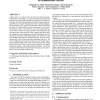Free Online Productivity Tools
i2Speak
i2Symbol
i2OCR
iTex2Img
iWeb2Print
iWeb2Shot
i2Type
iPdf2Split
iPdf2Merge
i2Bopomofo
i2Arabic
i2Style
i2Image
i2PDF
iLatex2Rtf
Sci2ools
ISLPED
2004
ACM
2004
ACM
Microarchitectural techniques for power gating of execution units
Leakage power is a major concern in current and future microprocessor designs. In this paper, we explore the potential of architectural techniques to reduce leakage through power-gating of execution units. This paper first develops parameterized analytical equations that estimate the break-even point for application of power-gating techniques. The potential for power gating execution units is then evaluated, for the range of relevant break-even points determined by the analytical equations, using a state-of-the-art out-of-order superscalar processor model. The power gating potential of the floating-point and fixed-point units of this processor is then evaluated using three different techniques to detect opportunities for entering sleep mode; ideal, time-based, and branch-misprediction-guided. Our results show that using the time-based approach, floating-point units can be put to sleep for up to 28% of the execution cycles at a performance loss of 2%. For the more difficult to pow...
| Added | 30 Jun 2010 |
| Updated | 30 Jun 2010 |
| Type | Conference |
| Year | 2004 |
| Where | ISLPED |
| Authors | Zhigang Hu, Alper Buyuktosunoglu, Viji Srinivasan, Victor V. Zyuban, Hans M. Jacobson, Pradip Bose |
Comments (0)

